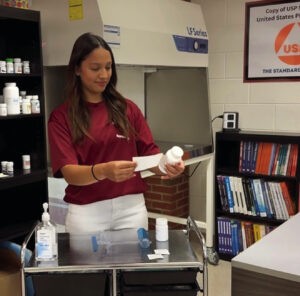Morgan deputies complete realistic domestic violence training
Morgan County sheriff ‘s deputies, in cooperation with Morgan County 911 and Decatur Morgan EMS, responded this week to simulated domestic violence scenarios in Somerville.
“The focus is the whole gamut, from the first phone call to the end – everybody that is involved is able to see it,” Sheriff ‘s Office spokesman Mike Swafford said Thursday.
Deputies from four patrol shifts trained Tuesday and Thursday against a backdrop of grain silos, bales of hay and plastic-paneled greenhouses. The simulated scenario involved a husband, role-played by Swafford himself, who shot his wife inside a small ranch house. First responders who participated in the training were unaware how the situation would unfold.
A Sheriff ‘s Office SWAT team, made up of patrol deputies, investigators and narcotics agents, also participated, along with Morgan County 911 dispatchers and Decatur Morgan EMS. Some dispatchers were on scene to observe rather than participate directly.
“It’s always good for dispatchers to see how the other side works,” said Jeanie Pharis, director of Morgan County 911. “Knowing some of the pressures responders are up against, how they set up at a scene and being able to visualize that helps (dispatchers) better help the responders.” Two patrol vehicles arrived on the property Thursday afternoon following a simulated 911 call. The vehicles stopped about 50 yards away from the residence, and patrol deputies exited the cruisers and took cover behind them while aiming their firearms toward the sound of a man (Swafford) screaming. One of the deputies periodically said things into his radio, such as: “one male inside the house.” A drone buzzed overhead as deputies advanced closer to the home, taking cover behind trees. Snipers hid in the woods surrounding the property. The female victim then ran out of the home and into the arms of a deputy who brought her behind cover.
“Sheriff ‘s Office, come out, show me your hands!” another deputy yelled. Then, the deputies retreated to the cover of their cruisers, while keeping their attention on the home, and radioed for a negotiator. Naturally, negotiations failed.
A while later, a SWAT team equipped with rifles and gear that you might see on a battlefield arrived and began advancing toward the home behind the cover of a slowrolling cruiser while assessing the tactical layout. All the while, back-and-forth radio communications continued.
“Get off my property!” Swafford yelled. “Don’t come in here!” “Clear to deploy gas at this time,” a radio chirped.
SWAT operators fired simulated tear gas rounds from a 40 mm launcher into the home, and Swafford exited while acting out a coughing fit. Some operators took him into custody, while others approached the front door and threw a flash-bang inside before clearing the house.
Afterward, everyone involved gathered in a circle to debrief.
“Traditionally, we have focused – and we still do – on active shooters in the schools,” Swafford said. “We usually do big training in the summer. But the sheriff rightly said, ‘Hey, I don’t want to change that, but I’d like for us to do something around these domestic violence issues.’ Because we’ll have three to four domestic violence calls a day.
“And, you know, just because of the heated situa-tion that they’re in, it can be very volatile. So, he wanted to prepare and make sure we’re all on the same page for that, so that’s where this came about.” The National Coalition Against Domestic Violence estimates nearly 38% of Alabama women will experience domestic violence in their lifetime. According to the most recent, incomplete data complied and published on the state’s crime dashboard website, there were 171 domestic violence crimes in Morgan County in 2023, for a rate of 137 per 100,000 residents. In 2022, there were 370 domestic violence crimes in the county, for a rate of 309 per 100,000 residents.
“A lot of times, especially out in the county, (people’s) property and home is kind of their kingdom, so now you have a third party showing up to an already-heated situation, so that can, unfortunately, escalate it more, because they don’t want us there,” Swafford said. “So, it’s just really being able to navigate all that, that’s what this training is built around.” Pharis said the training was especially helpful for dispatchers because it can sometimes be difficult to figure out what responders need or don’t need from the call center.
“This helps with patience on both sides, as well as a better understanding of information that may be important,” she said.








